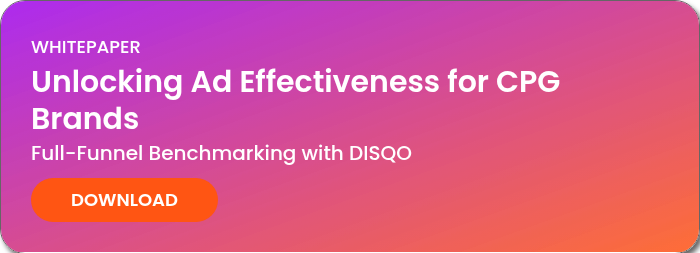Winning one of advertising’s most competitive arenas using marketing benchmarks
Consumer packaged goods marketers are navigating one of the most complex media environments in advertising. Once anchored in shelf placement and mass reach, the category now contends with fragmented channels, shifting consumer behavior, and rising pressure to prove outcomes across the full funnel.
Today’s consumers move fluidly between discovery and decision, acting on impulse or delaying purchase without warning. Brand equity and loyalty are tenuous, and attention is limited. Performance depends not only on the product but also on the precision and accountability of the media strategy behind it.
At DISQO, we partner with leading CPG brands to bring the clarity necessary to identify which channels drive meaningful brand outcomes and which tactics move the needle on performance metrics like site visits, search lift, and commerce activity.
Furthermore, this guide draws on benchmark insights from over 1,650 campaigns measured by DISQO, expanding on “Unlocking Ad Effectiveness for CPG Brands: Full-Funnel Benchmarking with DISQO’s White Paper, to show where CPG advertising delivers results, where it falls short, and how marketers can close the gap. It unpacks how social, CTV, and retail media platforms perform across the funnel and why full-funnel measurement is essential to smarter planning and spending.
Why full-funnel measurement matters for CPG brands
The traditional funnel still exists, but for many CPG brands, it no longer holds together. Campaigns often succeed in driving awareness, yet struggle to convert that visibility into consideration or intent. Consumers may recognize the brand but rarely recall it unaided. Favorability is common, but follow-through is not.
This drop-off reflects a structural gap. CPG brands rely heavily on retail distribution and often lack insight into the digital behaviors that signal intent. Without a clear link between brand exposure and the moment of purchase, interest fades before it can turn into action.
To move forward, marketers must shift focus:
- Aided awareness is a starting point, not a measure of success. High awareness means the campaign reached an audience, but it does not confirm whether that audience is primed to engage or buy. True performance starts when consumers begin to consider, search for, or act on the brand.
- Benchmarks give context to lift. Without them, results are abstract. Knowing that a campaign lifted awareness or favorability is not enough. Marketers need to know how that lift compares to industry norms, past efforts, and peer performance to understand whether the result is meaningful or leaves room for improvement.
- Measuring only sentiment misses the behaviors that matter. Favorability is valuable, but it’s not the end goal. Without connecting attitudinal lift to digital behaviors—such as branded search, ecommerce, or retail site visits—marketers cannot fully understand how campaigns influence the path to purchase.
Most campaigns are planned to perform, but too few are measured to prove it. For CPG brands, full-funnel clarity is no longer optional. It is essential for making smarter creative, media, and budget decisions that move the business forward.
Assessing CPG advertising channels
CPG marketers are working across more channels and platforms than ever, but not all of them deliver the same type of impact. Each channel plays a distinct role in the funnel, and understanding those roles is essential to building campaigns that work as a system, not in silos.
- Social media excels at driving awareness and intent. It delivers outsized lift in purchase consideration and action, especially in impulse-driven categories. But it isn’t where consumers go to compare brands or search for alternatives.
- Connected TV builds long-term equity. It performs strongly on favorability and consideration, offering the space and attention needed for emotional storytelling.
- Retail media networks help close the loop. Combining brand exposure with direct access to the cart gives CPG advertisers rare proximity to the point of sale.
Marketers should assign clear objectives to each channel to build a full-funnel strategy. That means defining not just where media runs, but what it’s meant to do and measuring accordingly. A channel’s success should be judged by the outcomes it’s built to influence, not by surface-level engagement.
Better CPG advertising starts with smarter benchmarking
To navigate saturated categories, fragmented data, and indirect purchase paths, CPG brands need clear visibility into how campaigns drive both perception and behavior. That’s what full-funnel deterministic measurement delivers.
DISQO’s Brand Lift and Outcomes Lift solutions provide a unified view of what people think and do—measured consistently across platforms. This dual lens is critical for CPG marketers, where awareness alone is not enough, and purchase behavior often happens outside of direct sales channels.
For a deeper look at how CPG campaigns perform across awareness, consideration, and conversion, download Unlocking Ad Effectiveness for CPG Brands: Full-Funnel Benchmarking with DISQO. The white paper includes real-world examples and a practical playbook to help you plan, measure, and optimize with confidence.





